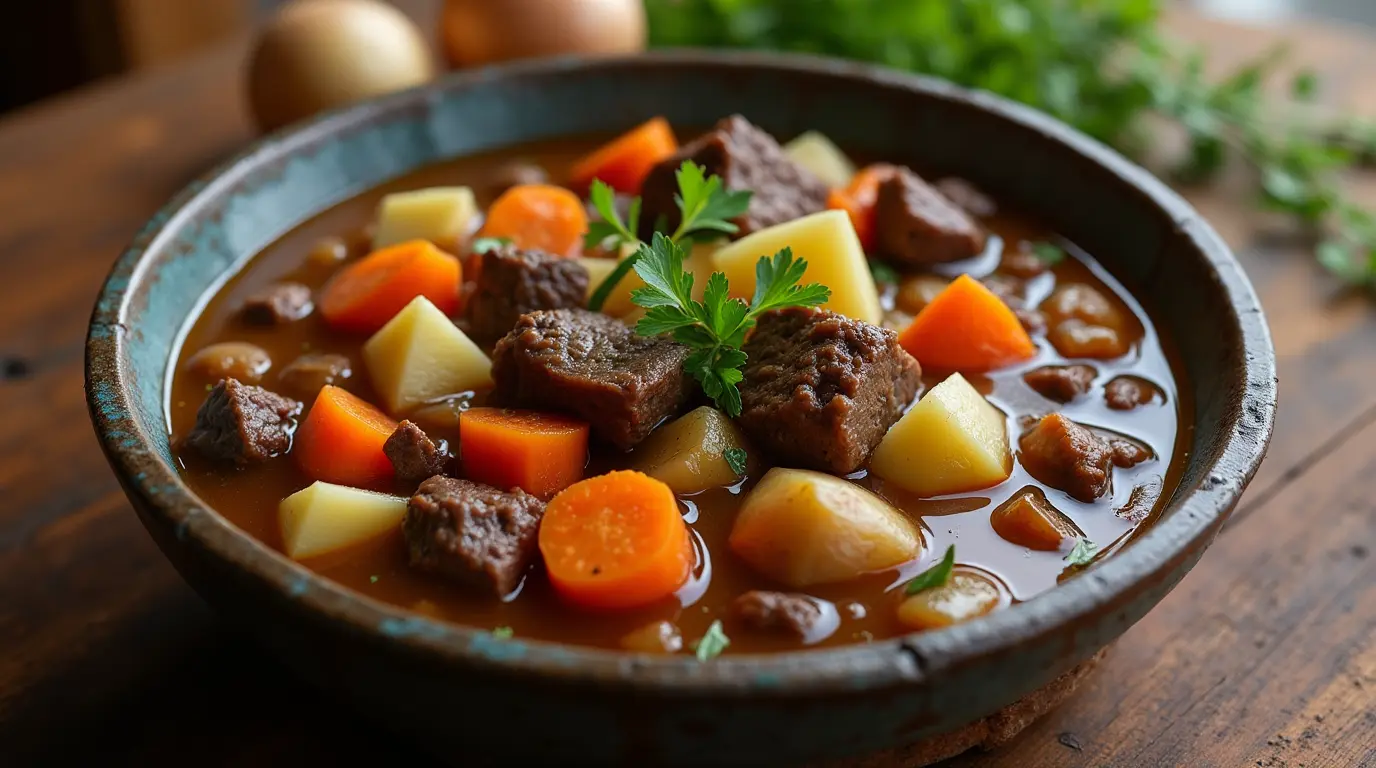Comfort food that doesn’t wreck your diet? Yes, please.
Beef stew is more than just cozy, it’s a nutrient-rich powerhouse hiding under all that comfort. Packed with protein, iron, and veggies, it can easily become part of a balanced, wholesome meal. In this guide, we break down what’s really in your bowl and how to make your stew even better for your health goals.
Table of Contents
What Makes Beef Stew Nutritious?
Beef stew stands out as a nutrient-dense dish that combines a variety of wholesome ingredients. The star of the show is beef, which is a fantastic source of high-quality protein. This macronutrient not only helps build muscle but also supports tissue repair and hormone production. Alongside beef, hearty vegetables like carrots, potatoes, and celery bring essential vitamins and minerals to the table.
One of the unique benefits of beef stew is its versatility. You can adjust the ingredients to cater to specific dietary needs or preferences, making it an excellent choice for anyone looking to enjoy a balanced meal. From iron in the beef to potassium in the potatoes, this dish provides an impressive array of nutrients in one pot.
A Brief History of Beef Stew in Culinary Traditions
Beef stew has a long history across different cultures. From the French boeuf bourguignon to Irish beef and Guinness stew, this dish has been a staple for centuries. Traditionally, it was a way to use tougher cuts of meat, which became tender when simmered for hours. Over time, the recipe evolved, with each region adding its own spin using locally available vegetables and spices.
Today, beef stew remains a popular choice worldwide for its rich flavor and nutritional benefits. It’s a classic example of how simple ingredients can come together to create something extraordinary. Whether you’re serving it as a weeknight meal or a celebratory dish, beef stew continues to be loved for its versatility and health benefits.
Core Nutritional Components of Beef Stew
Calories and Macronutrients
Beef stew is a nutrient-packed meal, offering an ideal balance of macronutrients. A standard serving (around one cup) contains approximately 250–350 calories, depending on the recipe. This makes it a satisfying yet calorie-conscious choice for lunch or dinner. The beef itself is a protein powerhouse, contributing roughly 20–25 grams of protein per serving, which supports muscle repair and satiety.
Carbohydrates in beef stew come primarily from vegetables like potatoes and carrots, which provide essential energy for the body. Most recipes include around 20 grams of carbohydrates, a mix of simple and complex carbs. Meanwhile, the dish’s fat content typically 8–15 grams per serving depends on the cut of beef used and whether the recipe includes ingredients like butter or cream.
Micronutrients in Key Ingredients
Beef stew shines in its micronutrient profile. Beef is rich in iron, zinc, and vitamin B12, all crucial for maintaining energy levels and a healthy immune system. The addition of vegetables enhances the stew’s nutritional diversity:
- Carrots deliver a hefty dose of beta-carotene (vitamin A), supporting vision and skin health.
- Celery provides fiber and vitamin K, essential for bone health.
- Potatoes, beyond being a carbohydrate source, are loaded with potassium, which aids in maintaining healthy blood pressure.
Even the broth contributes to the stew’s nutritional appeal. Bone-based broths, often used as a base, are a source of collagen and minerals like magnesium.
Want to save time in the kitchen? Browse our Quick & Easy Recipes for nutritious meals that fit into any busy day.
Health Benefits of Beef Stew
How Beef Stew Supports Muscle Growth and Repair
The high-quality protein in beef stew is a standout feature, making it a go-to meal for fitness enthusiasts and athletes. Proteins are made up of amino acids, the building blocks your muscles need to recover after exercise. Beyond repair, protein-rich meals like beef stew promote long-term muscle growth, helping you stay stronger as you age.
Iron, abundantly found in beef, is another hero nutrient. It’s vital for transporting oxygen throughout the body, ensuring your muscles get the energy they need to perform.
Immune-Boosting Vitamins and Minerals
Beef stew doesn’t just build muscles; it also bolsters your immune system. Ingredients like garlic, onions, and fresh herbs, commonly added to the dish, have antioxidant and anti-inflammatory properties. The vitamin C in carrots and other vegetables further supports immune health by aiding in collagen production and boosting your body’s defense against illnesses.
The Role of Collagen from Slow-Cooked Broth
If your recipe includes a slow-cooked bone broth base, your beef stew nutrition gets an additional upgrade. Collagen extracted from bones and connective tissues is great for maintaining healthy skin, joints, and gut health. Slow cooking ensures the broth is nutrient-rich while amplifying its savory flavor.
For more ideas about enhancing your beef dishes, check out this detailed beef stew seasoning recipe.
Tips for Maximizing the Nutritional Value of Beef Stew
Adding Nutrient-Rich Ingredients
Enhancing the beef stew nutrition starts with choosing ingredients that pack a nutritional punch. Additions like sweet potatoes or butternut squash provide beta-carotene and fiber while naturally sweetening the stew. Tossing in legumes such as lentils or chickpeas boosts the protein and adds a plant-based dimension to the meal.
Incorporating fresh herbs like parsley or dill not only brightens the flavor but also adds antioxidants. For a vitamin boost, consider stirring in a handful of leafy greens like spinach or kale toward the end of cooking. These greens retain their nutrients best when lightly cooked.
Choosing High-Quality Cuts of Beef

Opting for lean cuts of beef, such as sirloin or top round, reduces saturated fat while maintaining the stew’s protein content. Grass-fed beef is an even better option, as it contains higher levels of omega-3 fatty acids and conjugated linoleic acid (CLA), both known for their health benefits.
Factors Influencing Nutritional Value
Ingredient Choices and Their Impact
The nutritional value of beef stew largely depends on the ingredients you use. Choosing lean cuts of beef, such as sirloin or chuck, can reduce the saturated fat content while maintaining the dish’s protein richness. Similarly, swapping starchy vegetables like potatoes with lower-carb alternatives, such as turnips or parsnips, can cater to specific dietary needs, like keto or low-carb diets.
Adding dark leafy greens, such as kale or spinach, boosts the vitamin content. These greens are high in iron and calcium, adding another layer of nutritional benefit. Don’t forget about the broth opting for a low-sodium stock reduces the overall sodium content, making your beef stew a heart-healthier option.
Cooking Methods: Slow Cooker vs. Stove vs. Pressure Cooker
How you cook beef stew significantly affects its nutritional profile. Slow cookers are excellent for preserving nutrients because they use lower temperatures over extended periods. This method is ideal for recipes involving bone broth, as it allows the collagen to fully develop.
On the other hand, pressure cookers retain nutrients by reducing cooking time, locking in vitamins and minerals that might otherwise degrade in traditional stovetop methods. However, prolonged stovetop cooking may result in some nutrient loss, particularly water-soluble vitamins in vegetables.
Low-Calorie and Diet-Friendly Variations
Beef Stew for Weight Loss Diets
Beef stew can be tailored to support weight loss goals. To cut calories, focus on adding high-fiber vegetables like zucchini and mushrooms while reducing the amount of oil or butter. You can also incorporate plant-based proteins like lentils or chickpeas for a nutrient boost without additional fat.
Seasoning your stew with herbs and spices instead of heavy cream or sauces is another way to keep it light while enhancing flavor. Popular seasonings like thyme, rosemary, and paprika complement the stew beautifully while keeping the dish calorie-conscious.
Keto, Paleo, and Low-Carb Beef Stew Recipes
For those following a keto or low-carb lifestyle, consider replacing potatoes with cauliflower or radishes. These alternatives mimic the texture of starchy vegetables but align with carbohydrate restrictions. Paleo diets can benefit from using grass-fed beef and skipping legumes, focusing instead on vegetables and bone broth.
Want to build meals around hearty classics? Explore Grandma’s Recipes for wholesome dishes passed down through generations.
Frequently Asked Questions (FAQs)
What is the secret to good beef stew?
The secret to a good beef stew lies in three things:
Searing the beef properly – Brown the meat in batches to build deep flavor through caramelization.
Low and slow cooking – Simmer over low heat for at least 2 hours to tenderize the beef and blend the flavors.
Layering ingredients – Add vegetables at the right time so they don’t overcook, and finish with a splash of acidity (like vinegar or tomato paste) to balance the richness.
What ingredients go in beef stew?
Classic beef stew typically includes the following ingredients:
Beef chuck (cut into cubes)
Onions
Garlic
Carrots
Potatoes
Celery
Tomato paste or crushed tomatoes
Beef broth or stock
Bay leaves and thyme
Salt and pepper
Flour (to coat the beef or thicken the stew)
Optional: red wine, peas, or mushrooms
What is the secret ingredient in a stew?
The secret ingredient in a stew is often umami, and one of the best ways to add it is with a small amount of soy sauce, Worcestershire sauce, or a spoonful of tomato paste. These deepen the flavor without overpowering the dish.
Some cooks also swear by a splash of balsamic vinegar or anchovy paste to enhance richness just enough to elevate the stew without being noticeable.
What enhances the flavor of beef stew?
To enhance the flavor of beef stew, focus on depth, balance, and seasoning:
Sear the meat for a caramelized crust.
Use aromatics like garlic, onions, and celery as a flavor base.
Add umami boosters such as tomato paste, Worcestershire sauce, or a dash of soy sauce.
Include fresh or dried herbs like thyme, bay leaves, or rosemary.
Deglaze the pan with broth or wine to capture browned bits.
Simmer slowly to let flavors develop over time.
Finish with acid – a splash of vinegar or lemon juice brightens and balances the richness.

